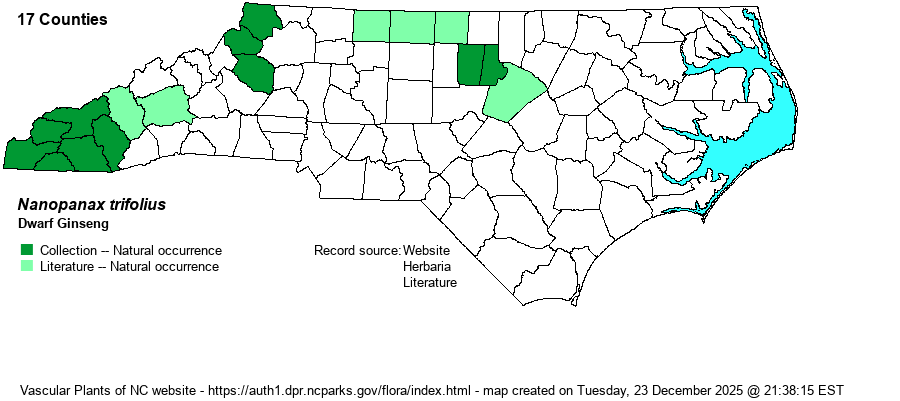| Author | (L.) A. Haines | |
| Distribution | Present in parts of the Mountains, and sparingly in the northeastern Piedmont; perhaps a real gap in the range.
This is a Northern species, ranging from eastern Canada south to northern GA and northern AL. | |
| Abundance | Rare to locally uncommon in the Mountains; very rare to rare in the northeastern Piedmont, where it seems to have declined in recent years (collecting pressure?). This is a Watch List species, formerly tracked as Significantly Rare by the NCNHP. The website editors feel that the S3 State Rank is too liberal, especially as the much more numerous P. quinquefolius is ranked at S3S4. A State Rank of S2S3 seems appropriate, if not S2. | |
| Habitat | This is a species of rich hardwood forests, and can be found in the same places as P. quinquefolius. It is most often seen in Rich Cove Forests, but it occurs in Mesic Mixed Hardwood Forests, in some bottomland forests, and other moist forests. |
| Phenology | Blooms from April to June, and fruits from August to October. | |
| Identification | This is a very small species, easily overlooked on a rich and highly diverse forest floor. It grows only to 3-4 inches tall on average. About 2 inches up the stem are the 3 leaves, emerging at a single point, and each leaf is palmately divided into 5 leaflets. The 2 lateral leaflets are tiny, but the middle 3 are still small, but at least elliptical to obovate and about 1.5 inches long and 1/2-inch wide, with serrated margins. From the top of the stem is a flower cluster (umbel) on a slender pedicel about 1-2 inches long, with a globe of white flowers about 2/3-inch across. After flowering, there are small drupes (yellowish), but these seem to not be often encountered. In leaf only, this plant can look much like other species such as Sanicula spp., or simply be overlooked completely. Even though the white "globe" of flowers is under 1-inch across, it is easily spotted, especially as a few dozen plants often can grow in close proximity. | |
| Taxonomic Comments | Arthur Haines (2020) provides ample reasons why this little plant should be split from Panax. Formerly named as P. trifolium or P. trifolius.
| |
| Other Common Name(s) | None | |
| State Rank | S3 [S2S3] | |
| Global Rank | G5 | |
| State Status | W1 | |
| US Status | | |
| USACE-agcp | | |
| USACE-emp | | |

